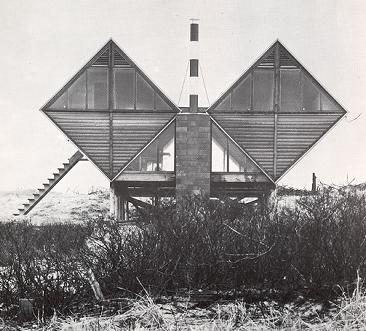Schwarz
View current page
...more recent posts
tiny houses rock walden rocks dave rocks
32 unknown pollocks discovered
Dia plans to move from its two spaces on West 22nd Street to 820 Washington Street, at Gansevoort Street. The new site is at the entrance to the High Line, the abandoned railway line 30 feet above the blocks between 10th and 11th Avenues, from Gansevoort Street to 34th Street, which is about to become a park with the help of $50.7 million in city money.
thanks to slema
the red hot jazz archive
from the red hot fmu message board
the ivory billed woodpecker spotted in ny
dee dee ramone -LIVE AND INTERVIEW AT E.J.'S IN PORTLAND, OREGON, JANUARY 19, 2000
joey and marky on stern
rare mp3s etc
ho boy! cribs marathon today on mtv!

By BRUCE LAMBERT
Published: May 6, 2005 for NYT
As soon as it was built in 1959, the beach house at 615 Dune Road in Westhampton Beach caused passers-by to stop in their tracks.
"The house stood out like a spaceship that landed on Dune Road, so it was quite an attraction," said Jonathan S. Pearlroth, who inherited the house.
Its unusual "double-diamond" geometric design, with two adjoining rectangular boxes tilted on their edges, quickly became an icon of modernism and was featured in magazines and books.
But the Pearlroth family eventually reached the reluctant conclusion that the double diamonds would have to go. It needed more room, Mr. Pearlroth said; old additions needed replacing and new laws barred expanding the original structure because it is in a storm damage zone. So the family hired an architect to design a larger replacement house and is ready to clear the site as early as May 15.
Hoping to rescue the house, preservationists are campaigning to move it to a new site, restore the original condition and transform it into an architecture museum.
"We're racing against the clock, trying to get the funding just to do the move," said Jake G. Gorst, the grandson of the house's architect, Andrew M. Geller.
Over the decades, the house had gradually faded from sight. Despite the beachfront locale, wind and waves built up the dunes so much that the house lost its prominence and even its ocean view. "It was buried," Mr. Pearlroth said.
Neighboring houses sprouted, and it was further hidden when the Pearlroth family expanded its living space by building decks and bedrooms around the original structure, which is just 600 square feet.
If preservationists succeed in salvaging the house, they can thank a series of lucky breaks.
Mr. Gorst, a filmmaker who was working on a documentary about his grandfather, interviewed Mr. Pearlroth in February. It was then that the owner sadly explained his demolition plans.
"We have such sentimental ties to the house - I loved it - it was painful for us to think we would knock it down," Mr. Pearlroth said this week.
The plan caught Mr. Gorst by surprise. But as they talked, a new idea suddenly dawned on Mr. Pearlroth.
"It was like a light went off in my brain," Mr. Pearlroth. "I said, 'Jake, please take the house if you can save it and do something with - it's yours.' "
Mr. Gorst leapt at the challenge, becoming part of the story he was filming. He spoke to Exhibitions International, a nonprofit group in Manhattan promoting 20th-century architecture, which agreed to raise money. Organizers figure they need $50,000 to move the house and $150,000 for restoration.
"It's coming in dribs and drabs so far," said the group's director, David L. Shearer. "We have a long way to go. The problem is the house is not 100 or 200 years old. People don't always appreciate the historic significance and need to preserve modern architecture."
The first hurdle is raising various utility cables so that the house can be slipped underneath. Cablevision has agreed to charge no fee, the organizers said, and they are in talks with the Long Island Power Authority and Verizon about their lines.
If the house can be moved, the next issue is where to put it - especially since vacant waterfront property in the Hamptons is almost as scarce as double-diamond houses and commands princely sums.
Once again, fate is intervening. As word of the fledgling campaign spread, an advocate in the American Institute of Architects, Anne R. Surchin of Sag Harbor, took up the cause.
"All the modern houses are being torn down left and right, and some are real classics," she said in an interview. "Sometimes you don't find out they're in danger till you see the bulldozers."
Linda A. Kabot, a member of the Southampton Town Council, said that after Ms. Surchin "sent me a frantic e-mail" she conferred with a fellow Council member, Steve Kenny. He suggested offering a site on the bay side of Pikes Beach park, a mile down the road.
Next Tuesday, the Town Board will hold a hearing on that proposal. The sponsors expect approval that day, to beat the move-it-or-lose-it deadline.
In one of many endorsements for the hearing, an architecture historian, Alastair Gordon, praised the house as "one of the most important examples of experimental design built during the postwar period not just on Long Island but anywhere in the United States." He called it "witty, bold and inventive."
With the proposed site surrounded by open space and the house to be elevated on stilts to prevent damage from stormy seas, the setting would recreate the original look of 1959, proponents say.
"It could be a wonderful architectural and navigators' landmark," Mr. Kenny said. "Perched high, almost like a work of art on a pedestal, the view looking out over the bay is going to be spectacular."
Mr. Geller, whose résumé includes work on the Lever Building interior, Windows on the World and Lord & Taylor's logo, recalled the Pearlroth house as "a one-of-a-kind" project that he did for fun.
Mr. Pearlroth's mother, Mitch, recruited the architect after reading about another house he designed. Mr. Geller said he studied the site and the family's living habits "previous to any doodling on paper."
Because the Pearlroths lived in New York City, Mr. Geller designed their beach house "to escape from the cell-like appearance of an apartment, to stay clear of four walls." The high-peaked ceilings also invoked the feel of an American Indian tent, he said.
The whimsical house inspired nicknames to match, including the Square Bra, the Box Kite, the Cat, the Milk Carton and the Reclining Picasso.
At 81, Mr. Geller said he was grateful for the effort to save the house. "I'm flattered," he said, "and I'm just thrilled."
jonathan s pearlroth sounds like a total load :
"It was like a light went off in my brain," Mr. Pearlroth. "I said, 'Jake, please take the house if you can save it and do something with - it's yours.' "a light just went of in my brain, let (inheritance-boy) pearlroth pay to move it. creep!
ps: would it kill the nyt and curbed to point out what a sleezy move this is?
housingmaps
tv party i didnt have cable then and completely missed it -
i did manage to catch alot of uncle floyd though. may have had to do with it being on free tv uhf channel 68.
project C-90
shigeru ban

Volunteers will be assigned a zone with about 300 trees, and will be trained to identify species, take measurements and assess health. They will also learn to identify the Asian long-horned beetle, which destroys hardwood trees. Beetle larvae have been spotted in two American elms in Central Park this spring. For years the parks department has been diversifying its tree population to deter insect infestations and the spread of diseases. "If the Asian long-horned beetle is infiltrating a certain area, we should diversify further," Mr. Benepe said. Volunteers "can enlist friends or bring their families," said Jennifer Greenfeld, the director of New York Tree Trust, a program of the parks department and the City Parks Foundation that is running the census. "Some of the folks who did it 10 years ago can't wait to do it again." For information on the census: 311, or www.nyc.gov/treescount.
perplexi
As a result, the major architectural players at ground zero - Mr. Libeskind, Mr. Gehry, Santiago Calatrava, David Childs, Mr. Arad and the Snohetta architects, to name the most obvious - have never sat down in a room together to discuss their growing concerns about the overall plan, let alone exchange ideas about how best to improve it.
This constitutes an enormous squandering of talent, as well as a total disregard for how the creative process unfolds. And it has essentially shut the public out of the process.
So far, such inflexibility has been justified by political calculations. Open discussion of what isn't working, and why, might slow the pace of rebuilding, the thinking goes, and send the wrong message to the world - as if indecision were somehow a sign of weakness. Given how the project has stumbled, that argument is looking more and more specious. And it ignores the fact that the city, and those of us who care about it, will have to live with the consequences of these decisions for decades.
Governor Pataki should take advantage of the most recent delays to take a big step back and rethink what has become a debased process. Planning should be open to intense public scrutiny. And by encouraging the architects to talk with one another and to the public they serve, he could finally take advantage of the talent that he has right under his nose.
right wing real estate blog "curbed" exclaiming 'bout 29-45 million dollar asking prices for modules in the calatrava tower and thi$ guy is yakking about it. that and all the different hats that calatrava wears. so what.
Known for her innovative space planning, Florence Knoll Bassett ("Shu" to her friends) recently designed an installation of her work at the Philadelphia Museum of Art. Since interviewing the legendary designer, I've become one of her many dedicated fans. Bassett defined the look for corporate interiors in the 1950s and profoundly influenced post-World War II design.
Mr. Rampe's departure comes at a particularly sensitive moment for a rebuilding effort that has recently been plagued by bad news. The construction of the Freedom Tower, the site's most prominent structure, is months behind schedule, and faces even greater delays after the New York Police Department last month delivered a disturbing assessment of its security shortcomings. Larry Silverstein, the lead developer of the site, has signaled that he may need hundreds of millions of dollars from the government to address the security concerns.
The decision by the Wall Street firm of Goldman Sachs to shelve plans for building a headquarters near ground zero was another setback. And to this day, three and a half years after the destruction of the two towers, a number of the architects, engineers and designers involved in the rebuilding effort have complained privately that a lack of creativity and communication still besets the project.
EDITOR'S NOTE: ArchNewsNow is going on the (Internet-deprived) road...the newsletter will return Wednesday, May 4. ------ It seems to be "culture vs. construction" all around NYC. -- Then there's NYC's Olympic bid, and recalling the city's two World's Fairs. -- It's back to the drawing board for Freedom Tower. -- Mulling mall plans in downtown Salt Lake City (developers will still have the last word - it's their money, after all). -- Forget baby boomers, Gen X'ers...now we have GUPPYS - green urban professionals who are young. -- A university builds a sustainable community in British Columbia. -- Starchitect-designed condos going for big bucks (like, $1,100/sq. ft.!). -- Two major projects opening in Ottawa and Montreal. -- Viñoly launches program of master classes and research grants. -- The Guggenheim continues to think big. -- Eco-friendly lumber gaining popularity (even Gibson Guitars has bought in).this is why ive been coming up short on the architecture stuff lately.
Three Songs by Leadbelly (1945)
This is the only known film appearance of the legendary singer. Edited by folk hero Pete Seeger. (9 min 18 sec)
from the wfmu blog... again.

